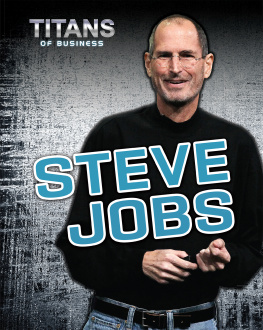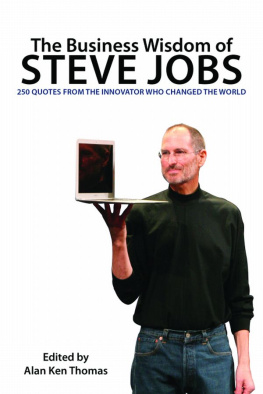Copyright 2015 by Brent Schlender and Rick Tetzeli
All rights reserved.
Published in the United States by Crown Business,
an imprint of the Crown Publishing Group,
a division of Penguin Random House LLC, New York.
www.crownpublishing.com
CROWN BUSINESS is a trademark and CROWN and the Rising Sun colophon are registered trademarks of Penguin Random House LLC.
Crown Business books are available at special discounts for bulk purchases for sales promotions or corporate use.
Special editions, including personalized covers, excerpts of existing books, or books with corporate logos, can be created in large quantities for special needs.
For more information, contact Premium Sales at (212) 572-2232 or e-mail .
Library of Congress Cataloging-in-Publication Data
Schlender, Brent.
Becoming Steve Jobs: the evolution of a reckless upstart into a visionary leader / Brent Schlender and Rick Tetzeli. First edition.
pages cm
1. Jobs, Steve, 19552011. 2. Computer engineersUnited StatesBiography. 3. BusinesspeopleUnited StatesBiography. 4. Apple Computer, Inc.Management. 5. Leadership. I. Tetzeli, Rick. II. Title.
QA76.2.J63S35 2015
338.76100416092dc23
[B] 2014031660
ISBN 978-0-385-34740-2
Ebook ISBN 978-0-385-34741-9
Jacket design by Michael Nagin
Jacket photograph: Doug Menuez/Contour by Getty from Fearless Genius: The Digital Revolution in Silicon Valley 19852000
v3.1
For Lorna, my lifesaver, many times over
BS
For Mari, forever
It is not often that someone comes along who is a true friend and a good writer.
RT
Contents
Authors Note
The reporting and writing of this book is the work of two authors. The two of us have worked together for years, going back to our time together at Fortune magazine. For Becoming Steve Jobs, we spent three years researching, interviewing, reporting, writing, and editing together. That said, in the narrative youre about to read, we decided, for conveniences sake, to use the first-person singular throughout to refer to Brent. Brent is the one who had a relationship of almost a quarter century with Steve Jobs, so using the word I made it much easier to tell our story.
Prologue
Youre new here, arent you? Those were his first words to me. (His last, twenty-five years later, would be Im sorry.) Already he had turned the tables on me. After all, I was the reporter. The one who was supposed to be asking the questions.
I had been warned about the unique challenges of interviewing Steve Jobs. The night before, over beers, my new colleagues at the San Francisco bureau of the Wall Street Journal had told me to bring a flak jacket to this first meeting. One of them said, only half jokingly, that interviewing Jobs was often more combat than questioning. It was April 1986, and Jobs was already a Journal legend. Bureau lore had it that he had dressed down another Journal reporter by posing this straightforward question: Do you understand anything at all, anything at all about what were discussing?
Id had plenty of experience with real flak jackets during my years reporting in Central America in the early 1980s. Id spent much of that time in El Salvador and Nicaragua, where Id interviewed everyone from truck drivers motoring through war zones, to American military advisers in the jungle, to Contra commandantes in their hideouts, to presidents in their palaces. On other assignments Id met with obstreperous billionaires like T. Boone Pickens and H. Ross Perot and Li Ka-shing, with Nobel Prize winners like Jack Kilby, with rock stars and movie idols, renegade polygamists, and even the grandmothers of would-be assassins. I wasnt easily intimidated. Yet for the full twenty-minute drive from my home in San Mateo, California, to the headquarters of NeXT Computer in Palo Alto, I brooded and fretted about how best to interview Jobs.
Part of my unease came from the fact that, for the first time in my experience as a journalist, I would be calling on a prominent business leader who was younger than I. I was thirty-two years old; Jobs was thirty-one and already a global celebrity, hailed, along with Bill Gates, for having invented the personal computer industry. Long before Internet mania started churning out wunderkinds of the week, Jobs was technologys original superstar, the real deal with an astounding, substantial record. The circuit boards he and Steve Wozniak had assembled in a garage in Los Altos had spawned a billion-dollar company. The personal computer seemed to have unlimited potential, and as the cofounder of Apple Computer, Steve Jobs had been the face of all those possibilities. But then, in September of 1985, he had resigned under pressure, shortly after telling the companys board of directors that he was courting some key Apple employees to join him in a new venture to build computer workstations. The fascinated media had thoroughly dissected his departure, with both Fortune and Newsweek putting the ignominious saga on their covers.
In the six months since, the details of his new startup had been kept hush-hush, in part because Apple had filed lawsuits trying to prevent Jobs from hiring away its employees. But Apple had finally dropped those suits. And now, according to the publicist from Jobss PR agency who called my boss at the Journal, Steve was willing to do a handful of interviews with major business publications. He was ready to start the public fan-dance that would begin to reveal in detail what exactly NeXT was up to. I was thoroughly fascinated, and equally wary; I didnt want to get taken in by the notoriously charismatic Mr. Jobs.


THE DRIVE SOUTH to Palo Alto is a trip through the history of Silicon Valley. From Route 92 in San Mateo over to Interstate 280, a bucolic eight-laner skirting San Andreas Lake and Crystal Springs Reservoir, which store drinking water for San Francisco piped in from the Sierras; past the blandly ostentatious venture-capitalist habitat along Sand Hill Road in Menlo Park and traversing the oblique, mile-long Stanford Linear Accelerator, which slashes like a hairline fracture through the landscape and beneath the freeway; past the Stanford Dish radio telescope, and the white-faced Herefords and ornate oak trees dotting the expansive greenbelt behind the university campus. The winter and spring rains had resurrected the prairie grass on the hills, turning them briefly as green as a golf course from their usual dull yellow, and peppering them with patches of orange, purple, and yellow wildflowers. I was so new to the Bay Area that I didnt yet realize that this was the most beautiful time of year to make this drive.
My exitPage Mill Roadwas the home street address of Hewlett-Packard, early biotech pioneer ALZA Corporation, Silicon Valley facilitators like Andersen Consulting (now called Accenture), and the law firm Wilson Sonsini Goodrich & Rosati. But first you hit the university-owned Stanford Research Park, with its groves of low-slung corporate research-and-development labs situated with lots of grassy elbow room. Xeroxs famed Palo Alto Research Center (PARC), where Steve first saw a computer with a mouse and a graphical bitmapped screen interface, resides here. This was where he had chosen to headquarter NeXT.














